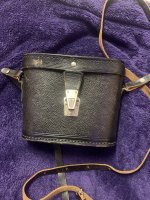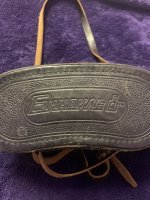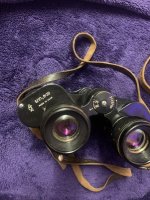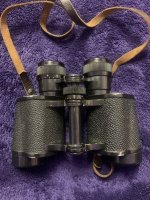A couple months back one of these came into my possession, part of a job lot of optics that the seller refused to split. Exterior glass was very hazy, but fortunately cleaned up fine, although unfortunately it looks like there is still some internal haze. I really didn't expect much from it, but after using it as my "by the window" binocular and having taken it out in direct comparison with my Zeiss West 8x30 (non-B) Saturday evening, I have to give the Soviets a certain amount of credit for producing a serviceable and useful binocular at a very economic price. Fit and finish is far less refined, some would say
crude, than the Zeiss West (but really not too far off the Zeiss Jenoptem I used to own) but actual build quality is solid, probably actually better than late model Jenoptems. All mechanicals (hinge, focuser, diopter) function as they should, although the diopter on mine is a touch lighter than I'd like. The long sleeves of the eyepiece assembly are an interesting touch, I suppose intended to help with weather resistance. Eye relief is a little longer than the Zeiss West 8x30 but not by very much. You'll still need to remove your glasses to use it.
Image wise the big downside, which cannot be ignored, is the very strong yellow cast, far exceeding that of any modern binocular. I'm not sure what the Soviet designers intended with that (easier viewing against snow-covered landscapes, maybe?). The Zeiss West 8x30, one of the more highly rated classic 8x30s, is, in direct comparison, brighter, clearer and significantly more natural in terms of colour rendition, and also seems much better against glare, but as mentioned I think the Komz has some internal hazing and would not be surprised if brightness, clarity, and possibly also performance against glare, might be improved after service (am mulling over whether to stump up the cash for this now). Field of view is exactly the same (tested against landmarks) although I can get the Zeiss West "nearer my eyes", making it feel somewhat wider.
The strong point of the Komz, as far as image quality goes, is sharpness. It is really not far behind the Zeiss West in this department at all, although edge performance is not as good. Distant swifts are a pretty good test of sharpness at distance, and the Komz was able to pick out the tiny fast-moving silhouettes cutting through the evening sky clearly and sharply. Juvenile peregrines playfighting 1km off, seen just before 1900, were easy by comparison. I couldn't see any chromatic aberration in crows heading northwards at about 250m distance, though I suppose I should note I don't seem susceptible to it; others may well differ. Sharpness and general observed detail on closer targets (numbers on football shirts worn by youngsters around 175m away) were really practically the same with both binoculars, except in two important respects: the Komz being visibly more affected by glare (which could be worked around to some extent by angling away from the evening sun) and that distinct yellow tint.
It's very far from being the best binocular out there, either in mechanical finesse or in overall image quality. Its design dates back to the 1930s and, not having the refinements evolved specifically for birding (fast focuser etc), is better suited to general observation. But it's still a sound binocular that, if one can ignore a couple of quirks (and I think the yellow tint is less of an issue in strong sunlight, like we now have in the southeast UK), can give good service. I'd like to see what the Komz in fully serviced condition can do.












